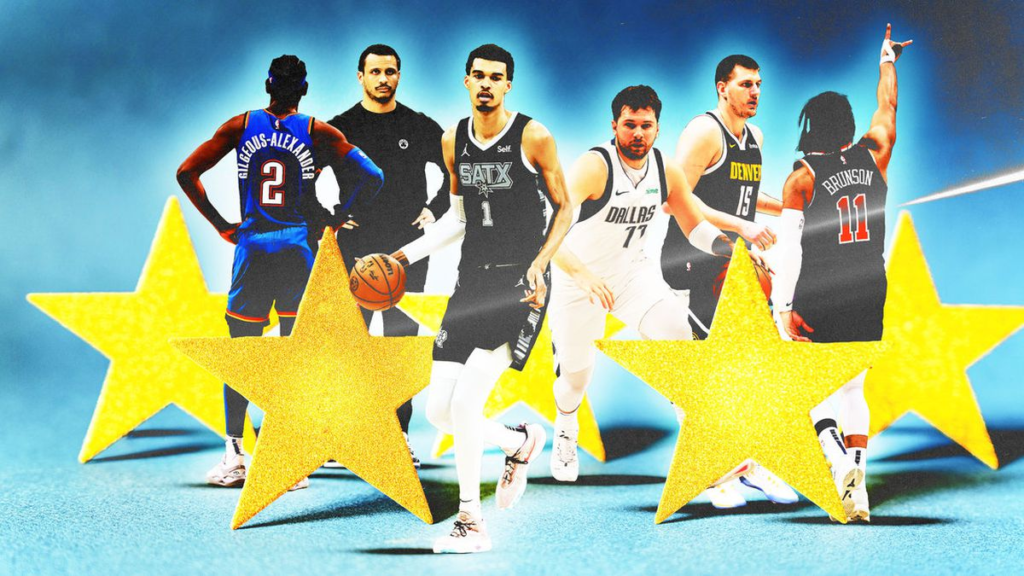
completing an awards vote at the conclusion of each NBA season. It is, indeed, taxing. However, it’s not the same as a genuine job. The process is enjoyable and lends credibility to six months of basketball, which are becoming more and more acknowledged by the majority (including league personnel) as being too dull and pointless.
Awards, however, bind the season together. With any luck, they will eliminate blustery heated takes and add context to those 82 games, highlighting the players who truly mattered and preserving their accomplishments in a time capsule. This is my formal contribution to the project, which is the result of a persistent addiction to League Pass and far too much time spent glancing at statistical datasets that are dispersed over the internet. Have fun!
Most Valuable Player
1. Nikola Jokic
2. Luka Doncic
3. Shai Gilgeous-Alexander
4. Giannis Antetokounmpo
5. Jalen Brunson
If you have even the slightest knowledge of the NBA, you can understand why Jokic is the clear winner. However, to give you a brief rundown, He is ranked highly in several major counting stats, including fifth in total points, second in total assists, second in total rebounds, and first in total plus-minus with an incredible 69.8 true shooting percentage in crucial situations. When you combine his near-total eclipse of most advanced catchall metrics with these accomplishments, his case is almost unbeatable.
The debates for any other contender evaporate when you add in his league-leading on/off point differential (the Nuggets are fighting for first place in the West and are practically invincible while Jokic is on the court, and he throws up when he sits). After finishing three seasons as the world’s most valuable, astute, and physically powerful player, Jokic continues to provide a challenge that the NBA’s other players haven’t even begun to attempt to solve.
There is an unbelievable amount of superstar potential in this league, but outside of Denver, a difference between Doncic and everyone else emerged this season. Whether we’re discussing production, influence, or competence in this particular situation, that may not seem like a contentious assertion. Examine these figures: 9.8 assists, 9.2 rebounds, 1.5 steals, and 33.9 points per game! Pull-up threes make up more than one-third of his shots, and he has sunk 38% of them. It isn’t just.
Doncic is a pick-and-roll ball handler who can read every defensive cover. Switch, and he can cause havoc in the paint by either taking that deadly stepback or blowing past too enthusiastic big players. Drop, and it’s a floating or lob. Blitz will receive an open three, and so will one of his teammates. Even though Doncic’s real usage rate decreased this season, he still led the league in that statistic while playing on a weak team that was hastily reconfigured in February to fully utilize his brilliance. This 25-year-old is capable of justifying foolishness, and Dallas has been competitive ever since.
After having a breakout season the previous year, SGA somehow leveled up this season, spending parts of it looking like the MVP. He leads the Thunder, who are vying for the top spot in the Western Conference, in predicted plus-minus. The only defenses that were able to implement a perfect game plan frequently found themselves at the mercy of a feathery midrange jumper that was second only to Luka’s stepback 3 as the tip-a-cap-then-hang-your-head shot of the season. OKC’s All-Star guard is a cunning, decisive blur; keeping him away from the basket is nearly impossible.
To pull apart, Gilgeous-Alexander had an excellent (and incredibly healthy) supporting cast surrounding him that helped shape those canyon-wide driving lanes, but Doncic did not have this luxury. Throughout the season, Doncic started in 25 different starting lineups (SGA started in six); his real usage rate was more than 10 percentage points lower than that of Dallas’s franchise player. To be clear, Gilgeous-Alexander leads the league in steals with an unquestionable vigor, thus there aren’t any significant weaknesses in his game. It’s okay if there is a dispute and he comes out on top as this year’s runner-up.
This takes us to a different two-time MVP winner, whose absence from any ballot should prompt the league office to look into the matter. The underappreciation of Antetokounmpo’s brilliance has occurred during a season marked by transition, suspense, and hardship that has been dangerously close to chaos. He is adored by all catch-all metrics. as they ought to. With an average of almost 30 points, a career-high 6.5 assists, and 11.5 rebounds per game, he’s never been more effective in terms of points per shot. Despite taking more shots than any other player in the restricted area—more than 180—Antetokounmpo is shooting 77.5 percent there. “Stat That Made You Lol the Hardest” would be a great contender for the end-of-season prize if it existed.
Things get a little trickier after those four contenders. When deciding who should be the Most Valuable Player, I strongly respect the word “valuable,” thus Brunson barely edges over Jayson Tatum. Only Luka has averaged more points per game since the All-Star break, but New York City’s favorite player was filthy this season, scoring the fourth-most points overall with a true shooting % above league average. When the score was five points or less, he made 41.6 percent of his three-pointers from beyond the arc, shooting nearly 40 percent from that distance.
It’s very remarkable. So is the only player who has had a net impact on his team’s offensive, ranking second only to Jokic. Throughout the season, Brunson is fourth in on-ball %, ninth in true usage rate, and fifth in predicted wins. With an absurdly high usage rate and an absurdly low turnover rate, Julius Randle has virtually become his team’s offensive weapon since he suffered an injury in late January. In the first round, the Knicks shouldn’t be vying for home court. They might, in some way, wind up with the second-best record in the conference because of Brunson for the first, second, and third reasons.






